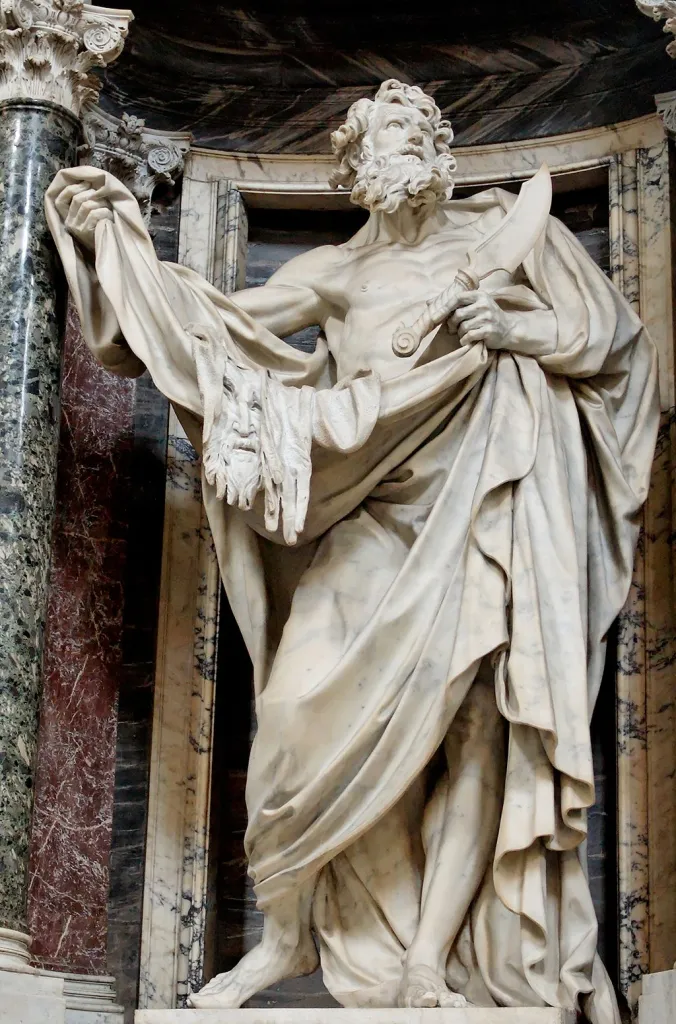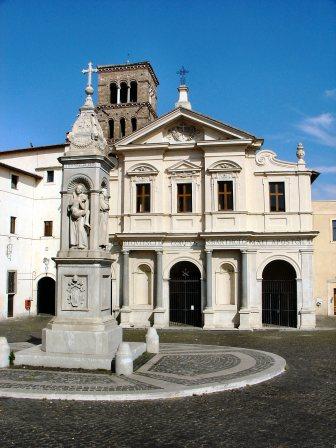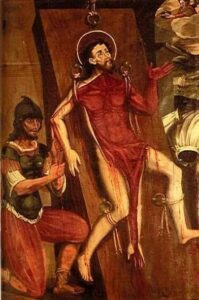 I post this a day in advance in case you might want to do some shopping for tomorrow.
I post this a day in advance in case you might want to do some shopping for tomorrow.
I have an affection for tomorrow’s (24 Aug) saint not only for the way in which he died (a way of being treated familiar to many priests of more traditional leaning) but also because my first ecclesiastical office was as rector of a small 700 year old church in Italy named for Sts. Peter and Bartholomew. Why it was named for that pair of saints is lost in time, I fear.
Here is the Roman Martyrology entry for today’s saint, the Apostle Bartholomew:
Festum sancti Bartholomaei, Apostoli, qui idem ac Nathanael plerumque creditus, Canae Galilaeae ortus, apud Iordanem a Philippo ad Christum Iesum ductus est; postea Dominus ad se sequendum eum vocavit et Duodecim aggregavit; post Ascensionem Domini Evangelium in India ipse praedicasse traditur ibique martyrio coronatus esse. …
The feast of Saint Bartholomew, Apostle, who is commonly believed to the same person as Nathaniel, sprung from Cana in Galilee, he was led by Philip to Christ Jesus at the Jordan; later the Lord called him to follow Him and we was reckoned among the Apostles; after the Ascension of the Lord it is traditionally held that he preached the Gospel in India and there was crowned with martyrdom.
St. Bartholomew is also known as Nathanael. One of the things that the Martyrology does not include is that Bart/Nate was the first person recorded to confess faith in Jesus as the Son of God. Find verses about him at Matthew 10:3; Mark 3:18; Luke 6:14; John 1:45-49, 21:2; and Acts 1:13.
St. Bartholomew is depicted in art either being flayed (his skin being peeled off his body while still alive) or holding a knife and sometimes his own skin. In the Sistine Chapel in Michelangelo’s Last Judgement you see the artist’s self-portrait in the face part of the skin which the Apostle is holding.
St. Augustine speaks about today’s Gospel reading which concerns Bartholomew and the meaning of the fig tree under which the future Apostle was sitting.
This passage might be a good point of reflection for somewhat loftier ecclesiastics.
It also returns us to our often encountered theme of Christ as Physician of the soul.
This is from Augustine’s Tractate on the Gospel of John 7 (on John 1:34-51 – emphases and comments mine, but not the translation).
20. Jesus then saw this man [Nathaniel = Bartholomew?] in whom was no guile, and said, “Behold an Israelite indeed, in whom is no guile.” Nathanael saith unto Him, “Whence knowest Thou me?” Jesus answered and said, “Before that Philip called thee, when thou wast under the fig (that is, under the fig-tree), ….
21. We must inquire whether this fig-tree signifies anything. Listen, my brethren. We find the fig-tree cursed because it had leaves only, and not fruit. In the beginning of the human race, when Adam and Eve had sinned, they made themselves girdles of fig leaves. Fig leaves then signify sins. Nathanael then was under the fig-tree, as it were under the shadow of death. The Lord saw him, he concerning whom it was said, “They that sat under the shadow of death, unto them hath light arisen.” What then was said to Nathanael? Thou sayest to me, O Nathanael, “Whence knowest thou me?” Even now thou speakest to me, because Philip called thee. He whom an apostle had already called, He perceived to belong to His Church. O thou Church, O thou Israel, in whom is no guile! if thou art the people, Israel, in whom is no guile, thou hast even now known Christ by His apostles, as Nathanael knew Christ by Philip. But His compassion beheld thee before thou knewest Him, when thou wert lying under sin. For did we first seek Christ, and not He seek us? Did we come sick to the Physician, and not the Physician to the sick? Was not that sheep lost, and did not the shepherd, leaving the ninety and nine in the wilderness, seek and find it, and joyfully carry it back on his shoulders? Was not that piece of money lost, and the woman lighted the lamp, and searched in the whole house until she found it? And when she had found it, “Rejoice with me,” she said to her neighbors, “for I have found the piece of money which I lost.” In like manner were we lost as the sheep, lost as the piece of money; and our Shepherd found the sheep, but sought the sheep; the woman found the piece of money, but sought the piece of money. What is the woman? The flesh of Christ. What is the lamp? “I have prepared a lamp for my Christ.” Therefore were we sought that we might be found; having been found, we speak. Let us not be proud, for before we were found we were lost, if we had not been sought. Let them then not say to us whom we love, and whom we desire to gain to the peace of the Catholic Church, “What do you wish with us? Why seek you us if we are sinners?” We seek you for this reason that you perish not: we seek you because we were sought; we wish to find you because we have been found.
[I wonder what Augustine would have thought about the public embarrassment and timidity of some Catholics today?]
22. When, then, Nathanael had said “Whence knowest Thou me?” the Lord said to him, “Before that Philip called thee, when thou wast under the fig-tree, I saw thee.” O thou Israel without guile, whosoever thou art O people living by faith, before I called thee by my apostles, when thou wast under the shadow of death, and thou sawest not me, I saw thee. The Lord then says to him, “Because I said unto thee, I saw thee under the fig-tree, thou believest: thou shalt see a greater thing than these.” What is this, thou shalt see a greater thing than these? And He saith unto him, “Verily, verily, I say unto you, ye shall see heaven open, and angels ascending and descending upon the Son of man.” Brethren, this is something greater than “under the fig-tree I saw thee.” For it is more that the Lord justified us when called than that He saw us lying under the shadow of death. For what profit would it have been to us if we had remained where He saw us? Should we not be lying there? What is this greater thing? When have we seen angels ascending and descending upon the Son of man?
I can’t think of a better way to honor the saint than eating ficchi e prosciutto that is, figs with prosciutto, both for the image from the Gospel and also for the thinly sliced strips of raw meat, which is more than appropriate today, and wondrous to taste I must say.
Given that it is Friday, perhaps you can do this tomorrow. I don’t think the saint would mind.
Here is the Church in Rome where the body of the Apostle is found. San Bartolomeo is on the island in the Tiber River.


 22. When, then, Nathanael had said “Whence knowest Thou me?” the Lord said to him, “Before that Philip called thee, when thou wast under the fig-tree, I saw thee.” O thou Israel without guile, whosoever thou art O people living by faith, before I called thee by my apostles, when thou wast under the shadow of death, and thou sawest not me, I saw thee. The Lord then says to him, “Because I said unto thee, I saw thee under the fig-tree, thou believest: thou shalt see a greater thing than these.” What is this, thou shalt see a greater thing than these? And He saith unto him, “Verily, verily, I say unto you, ye shall see heaven open, and angels ascending and descending upon the Son of man.” Brethren, this is something greater than “under the fig-tree I saw thee.” For it is more that the Lord justified us when called than that He saw us lying under the shadow of death. For what profit would it have been to us if we had remained where He saw us? Should we not be lying there? What is this greater thing? When have we seen angels ascending and descending upon the Son of man?
22. When, then, Nathanael had said “Whence knowest Thou me?” the Lord said to him, “Before that Philip called thee, when thou wast under the fig-tree, I saw thee.” O thou Israel without guile, whosoever thou art O people living by faith, before I called thee by my apostles, when thou wast under the shadow of death, and thou sawest not me, I saw thee. The Lord then says to him, “Because I said unto thee, I saw thee under the fig-tree, thou believest: thou shalt see a greater thing than these.” What is this, thou shalt see a greater thing than these? And He saith unto him, “Verily, verily, I say unto you, ye shall see heaven open, and angels ascending and descending upon the Son of man.” Brethren, this is something greater than “under the fig-tree I saw thee.” For it is more that the Lord justified us when called than that He saw us lying under the shadow of death. For what profit would it have been to us if we had remained where He saw us? Should we not be lying there? What is this greater thing? When have we seen angels ascending and descending upon the Son of man?
































Pingback: THVRSDAY MORNING EDITION – BigPulpit.com
I ask his intercession everyday. He is the Patron Saint of my Trade Plastering!
And that other stones be laid in place of them that were taken away,and the house be plastered with other mortar. Leviticus 12:42